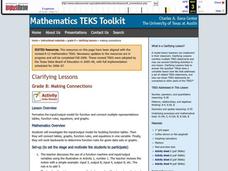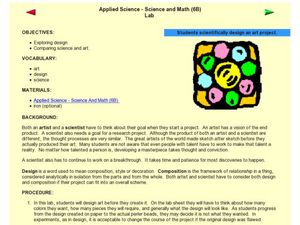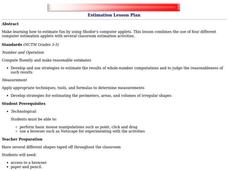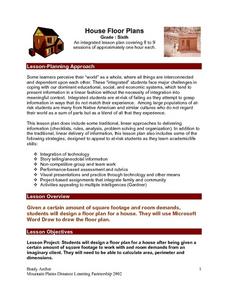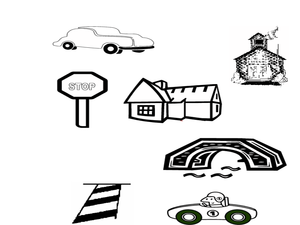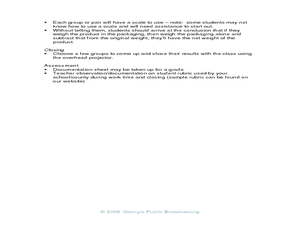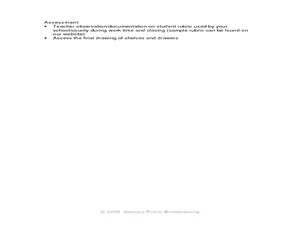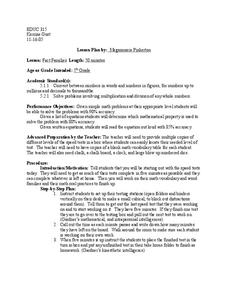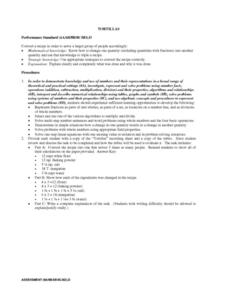Curated OER
More Pizzas and Things
Students are introduced to the problem by playing a guessing game of "I am a number, which is half of 6 and 6, what am I?" They explain their answers and see if anyone else had an alternate solution checking for reasonableness.
Curated OER
Favorite Foods at Thanksgiving
Fourth graders study different types of graphs as a means of displaying information. They survey others to find their favorite Thanksgiving food and then graph the results using different types of graphs.
Curated OER
Water - Planning for the Future
Middle schoolers explore and examine the increases and/or decreases for water user groups: irrigation, municipal, manufacturing, steam electric power generation cooling, livestock, and mining. They utilize percentage changes during their...
Curated OER
The Night Sky
Third graders develop questions they have about the solar system. After being read a book, they view and discuss different constellations in the sky. In groups, they are given a piece of butcher paper and glow in the dark crayons in...
Curated OER
Making Connections
Eighth graders investigate the input/output model for building function tables. From the data, 8th graders connect tables, graphs, function rules, and equations in one variable. They work backwards to determine function rules for given...
Curated OER
Precalculus: Function Models for Real-Life Situations
Students use calculators and "by hand" techniques to compare models of real-life data situations, determine the best model for a situation, and use their models to make predictions.
Curated OER
A Shapely Activity
Fifth graders explore polygons in various shape activities. For this polygons lesson, 5th graders discuss and identify polygons by their number of sides. Students sort ceramic tiles by the number of sides on each piece. Students explore...
Curated OER
The Best Vacation Ever
Learners research various vacation destinations and the costs of travel. In this vacation planning lesson, students obtain information for various purposes, research sites, document their findings, learn about geographical regions, and...
Curated OER
Chapter 5 Solving Problems
Students explore the concept of algebra topics. In this algebra topics instructional activity, students solve linear and quadratic equations. Students solve systems and factor equations. Students practice problems involving perfect...
Curated OER
Spark Activity: Counting Laps
Students move around a makeshift "track" set up by the teacher, moving around it as many times as they can before the stop signal. Students begin by power walking and slow-jogging, then build up speed as they proceed. Students call out...
Curated OER
Graphing Inequalities and Shading
Students graph and shade inequalities. In this algebra instructional activity, students graph inequalities using the slope-intercept form. They shade the side of the line that is the solution and identify the domain and range.
Curated OER
An Introductions to Congruent Polygons
Students differentiate between similar and congruent polygons. In this geometry instructional activity, students define the theorems and reasons for polygons similarity and congruence. They are given pictures and patterns to...
Curated OER
Science and Art Design
Students explore the scientific process by completing a pegboard activity. In this art design lesson, students identify the similarities between the art process and the scientific method while experimenting with art beads and templates....
Curated OER
Class Ketchup
Students describe statistics by conducting a class cooking activity. In this ketchup lesson plan, students conduct a class survey based on ketchup consumption habits by students. Students utilize tomatoes, water and a bottle to create...
Curated OER
Estimation
Students complete computer activities about estimating if items are more or less than a given amount. In this estimation lesson plan, students also estimate measurements around the classroom.
Curated OER
House Floor Plans
Sixth graders investigate the mathematical concept of area. They are given a certain square footage and asked to draw the initial floorplan for a house. Students use computers to create the plan. To finish the drawing it must include the...
Curated OER
Designing a Safe City Like a Civil Engineer
Students study civil engineering, safety apparatuses in their city, and design their own city. In this civil engineering lesson, students discuss their towns safety apparatuses and define civil engineers. Students then design their own...
Curated OER
Tear + Net = Gross
Second graders find the net weight of a grocery item by weighing it with the tear. In this weight measurement lesson, 2nd graders bring in cans of food and watch a video about weight measurement. Students review the meanings of gross,...
Curated OER
Shelves and Drawers: A Fraction Lesson
Second graders explore fractions as something shared evenly. In this fractions lesson, 2nd graders watch a video and discuss how bookcases and drawers could be divided evenly.
Curated OER
Fact Families
Fifth graders explore fact families. They solve simple math problems. Students determine which mathematical property is used to solve the given problem. They are given five minutes to complete as many mathematical facts as possible.
Curated OER
Tortillas
Students convert recipes for tortillas. They calculate the amounts of ingredients as they convert recipes and write an explanation of the task to demonstrate their calculations. After reviewing their calculations, they demonstrate how...
Curated OER
Equivalent Fractions
Students study the concept of equivalent fractions using naming concepts.
Curated OER
Playing With Probability
Sixth graders investigate probability. They use ratios to solve simple probability situations. Students express their solutions in the form of fractions or decimals. They predict outcomes and complete probability worksheets.
Curated OER
Basic Sense
Fifth graders add fractions. After a class discussion on real life application of fractions, the teacher uses fractions strips to model adding fractions. In pairs, 5th graders model adding fractions by drawing diagrams. They justify...




